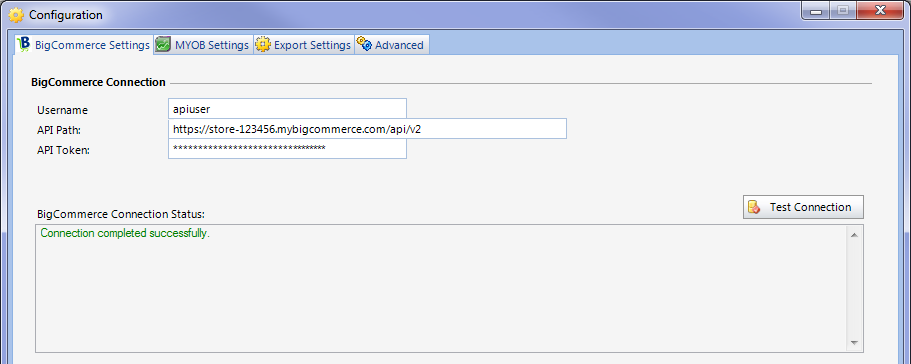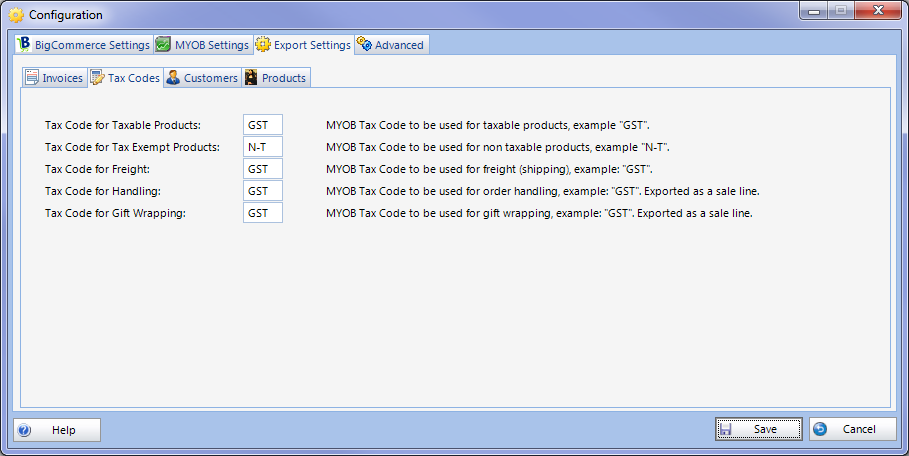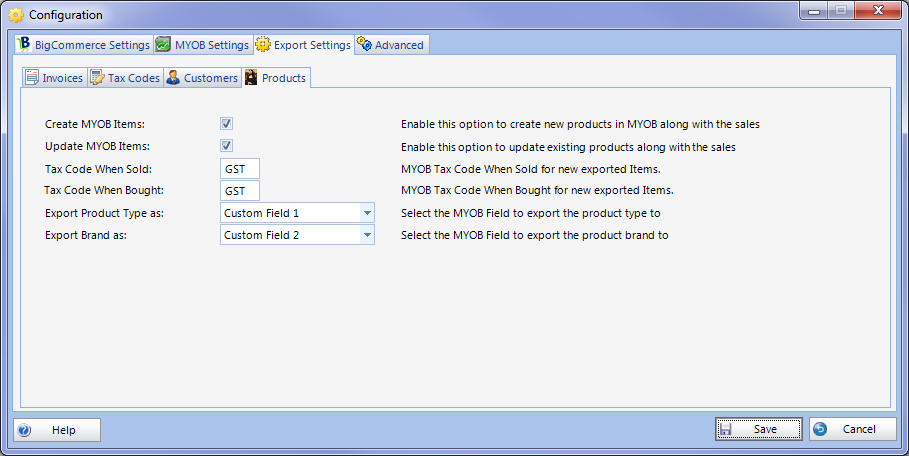Please make sure you also follow the instructions for the Settings in your MYOB File and the Settings in your BigCommerce Shopping Site.
This screen will automatically show the first time you run the Integration tool. It can be later called from the "Configuration" menu on the application's main screen.
The screen is divided into the following tabs.
BigCommerce Settings tab
This tab allows you to enter the credentials to access your BigCommerce shopping site so that orders can be fetched.

Before entering the user's credentials on this screen you will have to enable one BigCommerce user to have API access. Do this from the User's module in the BigCommerce administration portal. For more detailed information on how to do this please refer to the "Enable Access to the API" section in the Settings in your BigCommerce Shopping Site help document.
After entering all fields: the user name, the API Path and the API token click the Test Connection button and read the test results in the status box as shown on the image above. Possible errors may include:
- Wrong credentials: Check if the BigCommerce user account is enabled to access the API and has the minimum required role permissions as explained in the "Enable Access to the API" section in the Setting in your shopping site help document.
- Failure to connect to the server: Request assistance from your network administrator to diagnose connectivity issues to the URL specified in the API Path field.
- Others: Report them to Innovent Business Solutions for assistance.
MYOB Settings tab
This tab allows you to enter the credentials to access your MYOB file so that invoice sales can be written.

Provide this screen with your credentials to access your MYOB file:
- MYOB File Location: Enter your company's MYOB file. It is strongly recommended that you enter this in a UNC path format instead of using a driver letter even when the file is in the local computer.
- User name and Password: Enter the credentials of an MYOB user. It is recommended that you create an account to be used exclusively by this integration instead of using an existing account to prevent locking for concurrent access with the same user account.
- Application location: Enter the path to your MYOB executable file. It has to be in the local computer where your MYOB Accounting package is previously installed.
- Country and MYOB Version: Select the file version number and the country of your MYOB file.
After entering your credentials click the Test Connection button and read the test results in the status box as shown on the image above. Possible errors may include:
- Wrong credentials: Check that the user name and password are entered correctly or check if the user is active in MYOB.
- Cannot open the MYOB file: try launching the Integration as an administrator.
- Other: Report them to Innovent Business Solutions for assistance.
Export Settings tab
This tab controls the parameters required to export information into MYOB.
The screen is organised in the following sections:
Invoices section

| Export Sales as: | Select the sales format as you require it in MYOB. Available options:
|
| Tax Inclusive: | Indicate if amounts will be shown by default as tax inclusive or exclusive of taxes in MYOB. Once exported you can always swap the view. |
| Delivery Status: | Indicate the delivery status for exported sales. Available options:
|
| Invoice Number Format: | The invoice number in MYOB will come from the order's number in BigCommerce. This setting allows you to specify the length of it which will pad the number with trailing zeroes and optionally specify a character to be used as a prefix to help prevent clashes with any existing invoice. For example, if the order number is 165, and you set this setting to a length of 7 with a prefix of "A" then the invoice number stored in the exported sale will be A000165. |
| Category: | If you have Categories activated in your MYOB file then you must enter the name of one from your existing Category List in MYOB which will be used to tag every exported invoice. If you don't have Categories enabled then leave this box empty. |
| Job: | If you work with Jobs in MYOB and need to tag every invoice line with one then enter the Job number in this box. This will apply to all exported sales. There is currently no functionality to dynamically map to different job numbers. |
| Location: | If your MYOB file works with multiple inventory locations then use this box to indicate the location code where all item sales will be allocated. If you are using the default location only then leave this box empty. |
| Order Handling Item Number: | If an order includes a handling cost, it will be exported to MYOB as a sale item line. You need to have an item created in MYOB for order handling and enter its item number in this box. For more information on this please refer to the Order Handling Item section in the Settings in your MYOB File help document. This field is case sensitive. |
| Gift Wrapping Item Number: | If an order included a gift wrapping cost, it will be exported to MYOB as a sale item line. You need to have an item created in MYOB for gift wrapping and enter its item number in this box. For more information on this please refer to the Gift Wrapping Item section in the Settings in your MYOB File help document. This field is case sensitive. |
| Register full payment | Enable this option if invoices are to be exported to MYOB as paid, leaving them closed and with no outstanding balance. This will create a Receive Payment transaction in MYOB for every exported sale. |
| Deposit Account | Deposit Account to be used for the Receive Payment transaction if invoices are exported as paid. |
| What customer will be used for exported invoices? | Available options:
The number of customers in BigCommerce can be quite extensive and you may not necessarily be interested in their data in MYOB for your accounting. For this reason the second option if offered to use a single customer for all orders. In this way all orders will be exported against the same customer card which you will have to manually create in MYOB. |
| Customer Card ID for all orders | This field is only available if you choose to export all orders against a single customer. This is where you will enter the Customer Card ID for the customer to use for all orders. You will need to create this customer card in MYOB manually, assign a proper card ID to it and then enter that card ID here. |
Tax codes for invoices section

| Tax Code for Taxable Products: | Enter the MYOB Tax Code to be used on exported sales for taxable products (products using the Default Tax Class). Example: GST. |
| Tax Code for Tax Exempt Products: | Enter the MYOB Tax Code to be used on exported sales for non taxable products (products using the Non-Taxable Products Tax Class). Example: N-T. |
| Tax Code for Freight: | Enter the MYOB Tax Code to be used for the freight component in all exported sales. Example: GST. |
| Tax Code for Handling: | Enter the MYOB Tax Code to be used for order handling in all exported sales. Example: GST. |
| Tax Code for Gift Wrapping: | Enter the MYOB Tax Code to be used for gift wrapping in all exported sales. Example: GST. |
Customers section

| Create MYOB Customer Cards: | Enable this option if you want the Integration software to create new Customer Cards along with the exported invoices (recommended). The Integration software will only create them if it doesn't find the customer by its Card ID mapped with the Customer Card Format field in this section. Leave this box disabled if you want to manually replicate your customers in MYOB. |
| Update MYOB Customer Cards: | Enable this option if you want the Integration software to update any changes done to a customer into the Customer Card in MYOB such as the customer name, company name, email address or shipping addresses. |
| Customer Card ID Format: |
This option will shape the Card ID to be assigned to the exported customer based on BigCommerce's internal customer ID. This setting allows you to specify the length of it which will pad the number with trailing zeroes and optionally specify a character to be used as a prefix to help prevent clashes with any existing customer card. For example, if the customer ID is 444, and you set this setting to a length of 9 with a prefix of "C" then the Card ID stored in the exported customer will be C00000444. |
| Export Company Name as: | Use this option if you need the customer's company name exported to MYOB along with the customer. You can select one of the three customer's custom fields to write this data to. |
| Card ID for Guest Customers: | Enter the Customer Card ID the Integration will use for orders to guest customers. You must create this customer card in your MYOB file and enter the Card ID in this box. For more information on this please refer to the Guest Customer section in the Settings in you MYOB File help document. |
| Payment is Due, discount days, balance due days, discount for early payment, monthly charge for late payments and volume discount: | Customer Payment Term that will be used to create or update customer cards so that they default for all sales. |
Products section

| Create MYOB Items: | Enable this option if you want the Integration software to create new products along with the exported invoices (recommended). The Integration software will only create them if it doesn't find the product in MYOB's Items List by matching the Item Number with the SKU in BigCommerce. Leave this box disabled if you want to manually replicate your products in MYOB. |
| Update MYOB Items: | Enable this option if you want the Integration software to update any changes done to a product into the Item in MYOB such as the product name. |
| Tax Code When Sold: | Indicate the Tax Code When Sold to be exported for new Items. |
| Tax Code When Bought: | Indicate the Tax Code When Bought to be exported for new Items. |
| Export Product Type as: | Use this option if you need the product type exported to MYOB along with the product. Available product types in BigCommerce are physical or digital. You can select one of the three Item's custom fields or custom lists to write this data to. If you use one of the custom lists you should define your list values in MYOB first with the values: "digital" and "physical". |
| Export Brand as: | Use this option if you need the product's brand name exported to MYOB along with the product. You can select one of the three Item's custom fields to write this data to. |
Advanced tab
This tab shows other parameters required for technical support.

The option to enable the log file is useful for reporting an issue with the Integration software to Innovent Business Solutions. It logs all internal operations and captures the data being retrieved from your orders. The activation of this option can slightly compromise the application's performance so it's best to keep it disabled until requested during technical support.
